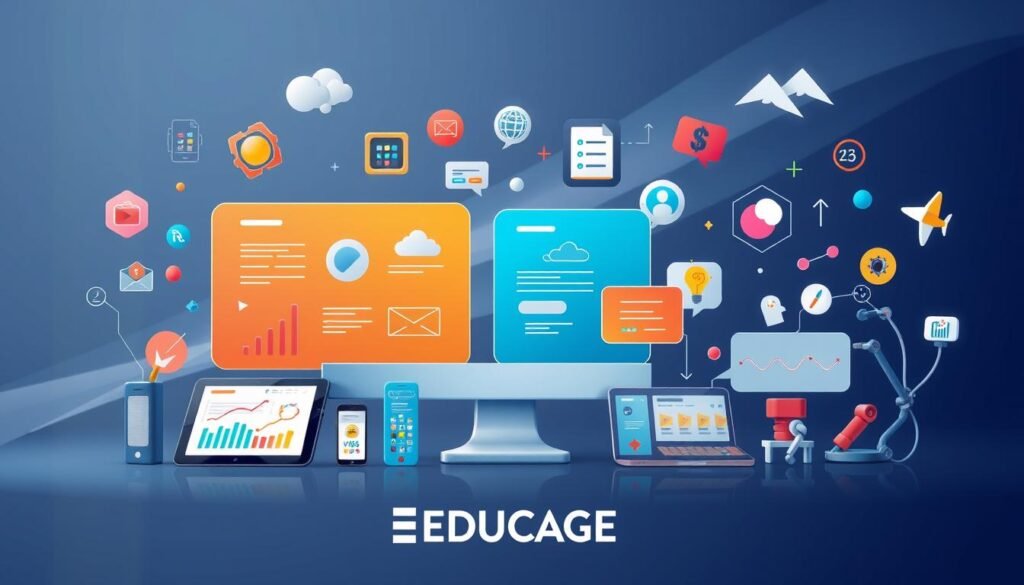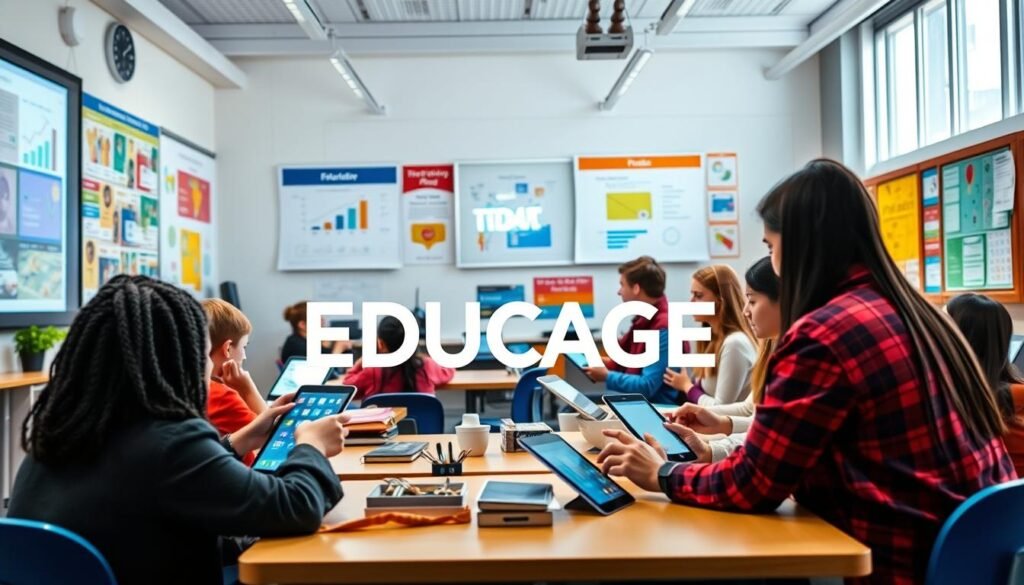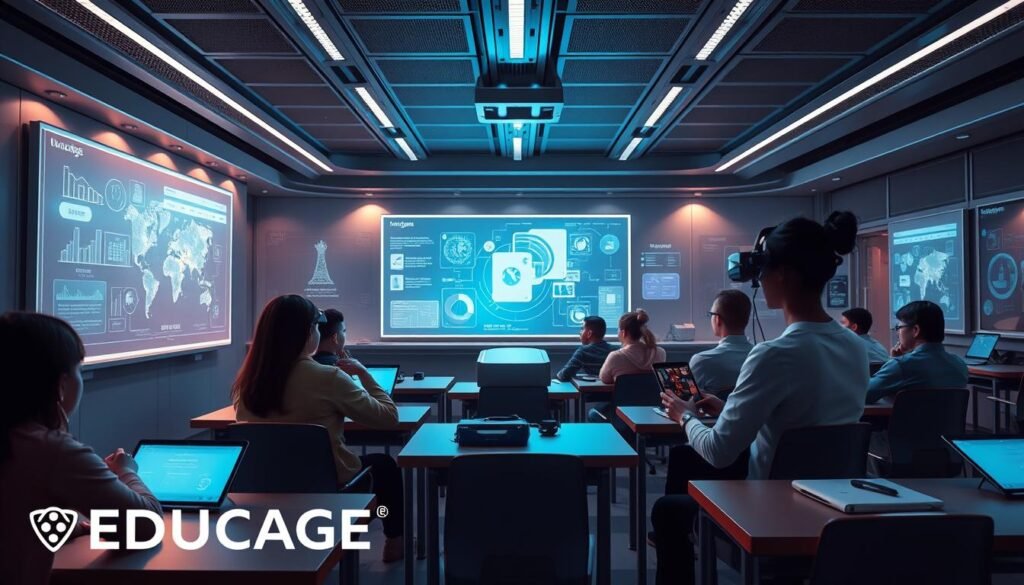“Tell me and I forget, teach me and I remember, involve me and I learn.” – Benjamin Franklin. This quote shows how powerful microlearning is in education. It’s a new way to teach that fits today’s fast-paced world. It breaks down learning into short, focused bits that everyone can handle.
Microlearning has been around for a long time, but it’s changed a lot with new tech. Now, we have the web and smartphones making learning easier and more fun. I’ll show you how microlearning is changing education, making it better for everyone. It’s becoming more popular, showing it’s really working to help people learn better1 and stay interested2. To learn more, check out this article.
Key Takeaways
- Microlearning is a transformative educational approach focusing on short, digestible content.
- This method aligns with modern students’ busy lives, enhancing learning flexibility.
- The technique has historical roots that influence its current adaptation.
- Microlearning supports various learning styles, promoting effective knowledge retention.
- The strategy is widely accepted in both educational and professional development contexts.
Introduction to Microlearning
The introduction to microlearning is a game-changer in today’s education. It breaks down learning into short, easy-to-digest bits. These bits usually take 1-15 minutes to get through3. This method fits perfectly into our fast-paced lives and boosts learning retention by over 20% compared to long-form content3.
Microlearning is versatile and widely used in schools and workplaces. It includes activities like quizzes, simulations, and short videos4. This makes learning fun and engaging.
Creating learning resources is also easier and cheaper with microlearning. It breaks down hard topics into smaller, easier-to-understand parts4. This way, learners can grasp information better.
Microlearning is not just convenient; it also motivates employees. It can even lead to higher salaries, showing its value for both workers and employers4.
This trend is great for learning new skills and practicing them right away. It works well in areas like Accounting, Customer Service, and IT3. By focusing on short content, learners can quickly review and remember what they’ve learned. This shows how effective and flexible microlearning is.
What Is Microlearning?
Microlearning is a new way to learn that breaks down content into short, focused bits. It makes learning fun and fits into busy lives. By understanding what is microlearning, you see it’s about learning in small, easy-to-digest chunks. You can learn anytime, anywhere. The definition of microlearning shows it works with many types of content, like videos, quizzes, and infographics.

Microlearning strategies believe in short, structured sessions for better memory. Research backs this up, showing that short, frequent learning boosts memory. People enjoy shorter formats because they fit into their daily lives5. Using online games and videos helps target specific skills or knowledge gaps quickly6.
It matches how often we check our phones; we do it nine times an hour7. This habit makes us want content that’s quick and engaging. Making content easy to consume boosts engagement and supports learning well.
Microlearning in Education
Microlearning has changed how we learn and share information. It focuses on short, specific pieces of knowledge to make learning more efficient. The characteristics of microlearning include being brief, easy to access, and engaging through multimedia.
Definition and Key Characteristics
Microlearning is about short, focused learning activities that fit different learning styles. It uses brief content to help remember information better and keep learners interested. Studies show microlearning can boost focus and memory by up to 80%, beating traditional learning methods8.
Also, since employees only have 1% of their time for learning, microlearning is a quick and effective way to learn8. Using videos and quizzes makes learning more fun and engaging9. Videos help learners remember information 95% better, showing how useful visuals are8.
Historical Background of Microlearning
The roots of microlearning go back to early learning methods that used short, focused sessions. The use of technology has made learning more accessible, especially on mobile devices. In 2020, 68.1% of all website visits were from mobiles, linking mobile learning to microlearning8.
This shift has made microlearning popular in many educational areas. It shows how adaptable and effective it is. With new teaching methods like flipped classrooms and gamification, microlearning keeps growing, meeting different learning needs9.
The Evolution of Microlearning Techniques
The evolution of microlearning has changed education a lot, especially since the 1990s. At first, we focused on making learning short and easy to understand. As technology got better, we found new ways to keep learners interested. Learning how microlearning has grown shows how it’s become more popular, thanks to smartphones and easy access to info.

Studies show microlearning can boost knowledge retention by up to 80%10. This is a big jump from old-school training. Now, we can share info in short chunks, usually under 10 minutes11. With almost everyone having a smartphone, learning on demand has become a hit since 201012.
Today’s tech is key to our microlearning techniques. For example, learning in short bursts helps fit into busy lives. This makes learning easy to do anytime, anywhere11.
| Aspect | Microlearning Benefits | Traditional Learning Methods |
|---|---|---|
| Average Duration | No longer than 10 minutes | Variable, often lengthy |
| Knowledge Retention | Improves by up to 80% | Less effective retention |
| Engagement | Highly engaging rates | Generally lower engagement |
| Flexibility | Access anytime, anywhere | Time-bound schedules |
| Customization | Personalized learning experiences | Standardized curriculum |
This evolution of microlearning keeps up with today’s learners. It moves from old ways to make learning more fun and effective12. Using many methods shows we need to keep changing how we teach.
Benefits of Microlearning in Modern Education
Microlearning is becoming popular in education for good reasons. It offers flexibility, better knowledge retention, and is cost-effective. Let’s dive into these benefits.
Flexibility and Convenience
Microlearning is super flexible. Its short modules, lasting just minutes13, fit into busy lives. You can learn whenever you want, anywhere, thanks to mobile access13.
Improved Knowledge Retention
Microlearning boosts knowledge retention a lot. Studies show it can increase retention by up to 80%14 and15. Spaced repetition helps keep important info fresh in your mind. This is key because we forget about 50% of new info within an hour14.
Cost-Effectiveness
Microlearning saves money for schools and businesses. It can cut development costs by 50% and speed up development by 300%15. Short, focused training keeps standards high while saving on costs13.
Microlearning Strategies for Effective Learning
Exploring microlearning strategies, I see how effective learning techniques boost the learning journey. Identifying tough topics for learners is key. By setting clear goals, I craft short, impactful content.
Microlearning modules are short, lasting 2–5 minutes. This makes learning easy to fit into busy lives16. Focusing on one skill at a time ensures learning is efficient. Adding quizzes and simulations makes learning fun and effective16.
Making content mobile-friendly is another plus. It lets learners learn whenever they want, making learning more accessible17. Allowing employees to share their learning also boosts knowledge sharing in the workplace17.
Visuals like infographics and short videos grab learners’ attention and help them remember better16. Spaced repetition strengthens learning, helping information stick over time16.
Measuring microlearning success through completion rates and quiz scores helps improve learning methods16. By using these strategies, I aim to create a dynamic learning space that meets the needs of all learners.

Examples of Microlearning in Education
Microlearning offers new ways to make learning better through easy-to-understand formats. It includes short video tutorials, interactive quizzes, and infographics. These methods make complex info simple and keep learners engaged, making learning fun and effective.
Short Video Tutorials
Short video tutorials teach specific skills or concepts well. They last 3-7 minutes, perfect for learners who are short on time. These video tutorials are great for quick learning on various platforms18.
Most eLearning experts agree that microlearning works well for students18.
Interactive Quizzes
Interactive quizzes are fun ways to check if you understand something. They offer quick feedback and help improve learning. By using quizzes, learners stay engaged and keep learning19.
Adding interactive elements like matching pairs makes learning stick better19.
Infographics and Visual Aids
Infographics make complex data easy to understand. They mix images, text, and charts to reach different learners. These visual aids make learning fun and informative19.
Using infographics with other microlearning tools keeps learning going and boosts critical thinking19.
| Microlearning Format | Duration | Benefits |
|---|---|---|
| Short Video Tutorials | 3-7 Minutes | Concise information delivery |
| Interactive Quizzes | Varies | Engagement and feedback |
| Infographics | N/A | Visual comprehension aid |
For more on microlearning examples, check out different platforms and methods19.
Implementation of Microlearning in Educational Institutions
Introducing microlearning in schools needs a careful plan to meet all learners’ needs. First, we check what’s missing in teaching and how students are doing. Then, we make microlearning fit the school’s goals.
Choosing the right content is key. Microlearning is short, lasting just a few minutes. This matches students’ short attention spans, which are about 8.25 seconds20. Using tech like Learning Management Systems (LMS) makes learning fun and interactive21.
Teachers need training to use microlearning well. With the right training, they can teach in new, effective ways. By using data from microlearning tools, schools can see how students are doing and improve teaching2022.
Microlearning makes schools modern and forward-thinking. It helps students learn on their own, preparing them for life outside school20. It also meets the needs of today’s students, who like quick, visual learning21.

Overall, microlearning can improve learning and engagement. It also helps schools save money2022.
| Implementation Steps | Description |
|---|---|
| Assess Institutional Needs | Identify gaps in current teaching methods and engagement levels. |
| Select Content Formats | Utilize materials designed for quick consumption, ensuring relevance to younger generations. |
| Educator Training | Equip teachers with training focused on microlearning strategies for effective content delivery. |
| Monitor Progress | Use analytics from platforms to guide curriculum refinement based on student performance. |
| Promote Lifelong Learning | Encourage students to develop self-driven learning habits that extend beyond classroom learning. |
Microlearning Platforms and Tools
Microlearning platforms are key in educational technology. They offer short, engaging content. This has changed how we learn, making it easier to access information.
Looking at different tools shows what makes good platforms stand out.
Popular Microlearning Platforms
Many microlearning platforms exist, each with its own features. Here’s a quick look at some top ones:
| Platform | Rating | Key Features | Price Range |
|---|---|---|---|
| Spekit | 4.6/5 | AI-generated training content, just-in-time learning | $0.00 – $139/month |
| Seismic Learning | 4.6/5 | Simplicity, cloud-based platform | $0.00 – $139/month |
| Guru | 4.5/5 | AI predictions, centralized knowledge access | $0.00 – $139/month |
| EdApp | 4.7/5 | Mobile training capabilities, gamification | $0.00 – $139/month |
| Tovuti LMS | 4.6/5 | Comprehensive training features | $0.00 – $139/month |
| Kahoot! | 4.6/5 | Gamified learning experiences | $0.00 – $139/month |
| Master-O | 4.7/5 | Content authoring, byte-sized playlists | $0.00 – $139/month |
Key Features of Effective Tools
Effective microlearning tools have certain features. These improve learning and ensure good results:
- Ease of use: Master-O is known for being easy to use, with a 4.7/5 rating.
- Adaptability: They offer flexible content to fit different learning styles.
- Analytics capabilities: Tools that track training progress are crucial.
- Engagement tactics: Features like gamification, found in Kahoot!, make learning fun.
By using these features, schools and companies can offer great training. Microlearning boosts knowledge retention by up to 50%23. It also improves employee engagement and success24.
“The role of microlearning in modern education cannot be overstated.”25
Microlearning for Student Engagement
In today’s schools, microlearning is key for keeping students interested and involved. It breaks down big topics into small chunks. This makes it easier for students to learn and join in on their lessons. Microlearning sessions are short, lasting up to 15 minutes, fitting well into busy school days26.
Using short videos, about 3 minutes long, helps students stay focused. They can easily go back to watch parts again. This helps them understand and remember what they learned26.
Enhancing Classroom Participation
Microlearning boosts classroom participation with its mix of teaching methods. Starting with polls helps students feel included and ready to participate26. Offering different ways for students to engage with the material also increases their involvement.
Tools like infographics make complex info easy to grasp. They’re a big part of microlearning, helping students quickly get the main points27. Adding fun elements, like points and badges, makes learning more fun. This boosts student interest and keeps them engaged27.
By using methods that appeal to students’ interests, we create memorable lessons. This approach makes learning more enjoyable and meaningful for them27.
Microlearning makes the classroom more lively and interactive. It lets students learn at their own pace, meeting their individual needs. This leads to happier and more successful students27.

Combining Microlearning with Traditional Learning Methods
My experience shows that mixing microlearning with traditional learning boosts educational results. Microlearning, or small chunks of content, fits how our brains learn28. It makes learning quick and engaging, leading to better participation and completion rates29. By blending these methods, teachers can use the best of both worlds.
Studies show that only about 6% of training time is spent on traditional methods, but 74% of corporate training now uses blended learning30. This shift towards mixing learning styles is significant. By adding microlearning to traditional methods, we make learning more effective and appealing to adult learners who prefer shorter, focused sessions29.
Here are some benefits of this mix:
- Enhanced Engagement: Microlearning boosts engagement, especially when combined with traditional teaching.
- Better Retention: Short formats help keep information in mind better than long sessions, making it easier to recall.
- Flexibility: Learners can learn at their own speed, fitting their learning style and schedule.
Using microlearning with traditional eLearning can lead to better learning results, showing that a mix can fill educational gaps28. For example, workers who mix their training are more likely to use their new skills than those who only have traditional training. Only 15% of those in traditional training apply what they learn30.
In summary, combining microlearning with traditional methods is key to creating new, effective educational approaches that meet different learning needs.
Microlearning in Professional Development and Training
Microlearning in professional development is becoming more popular for training employees. It offers short, focused sessions on specific skills, fitting well with today’s fast-paced work environment. This method uses the time employees already spend on screens, making learning easier31.
Microlearning focuses on one skill or topic at a time. This approach helps employees understand and retain information better because it’s practical and flexible32. It also encourages active participation, making learning more engaging and opening up opportunities for learning across different fields. Unlike traditional training, microlearning can be accessed anywhere, anytime32. Over 10 million learners have used Google Primer for its quick, interactive lessons on various topics31.
Microlearning helps institutions keep their workforce up-to-date with technology changes without overwhelming them. It uses personalized feedback through platforms like MobileMind to improve learning experiences. Animated videos and infographics are also effective in teaching complex information, helping learners grasp about 80% of what they see and hear31.
Merck’s use of Axonify’s microlearning platform is a great example. It saw an 80% voluntary participation rate among employees and a drop in incident rates at their manufacturing sites31. This shows that microlearning can teach critical skills and trends quickly, unlike traditional methods33.

| Feature | Microlearning | Traditional Learning |
|---|---|---|
| Duration of Sessions | Less than 5 minutes | Multiple hours |
| Access Flexibility | Anywhere, anytime | Specific locations and times |
| Engagement Methods | Interactive, gamified | Lecture-based |
| Focus on Skill Acquisition | Single outcome per course | Broad overview |
Challenges in Implementing Microlearning
Starting microlearning in schools comes with big hurdles. It’s key to know these challenges to make learning better and more engaging.
Resource Allocation
One big worry is resource allocation. Schools find it hard to have enough money and time for microlearning. Adults can only focus for 90 seconds, so learning materials must grab their attention quickly.
This means schools need to spend time and money on good content. They must plan well to meet learners’ needs, like learning at the right time and having all the resources they need.
Engagement and Interactivity
Getting learners to stay engaged with microlearning is tough. But, when done right, it can make learning faster and more fun. It boosts how well learners remember what they learn.
But, making learners interact with each other is hard. They’re used to old ways of learning. Breaking down big topics into small parts can leave them wanting more. They want to see how it all fits together.
Future Trends in Microlearning
Looking into the future of microlearning, I see a big move towards mobile learning and more gamification in schools. These changes make learning more fun and effective. Mobile learning lets people learn anywhere, anytime, which is great for their education.
About 75 percent of workers use their smartphones for work. So, learning on mobile devices is key in today’s job world34.
Impact of Mobile Learning on Microlearning
Mobile learning has changed microlearning a lot. Studies show people engage more with mobile training, up to 72 percent more than other methods. They also learn faster, up to 45 percent quicker, which helps them remember what they learn better.
Learning through videos is especially effective. People remember 95 percent of what they see in videos, compared to just 10 percent when reading. This shows how powerful mobile learning can be34. Also, learning apps can adjust to what each person needs, making learning more personal and helpful.
Growth in Gamification
Gamification in education is also on the rise. It makes learning more fun and can make training more effective. A study found microlearning can make training 50 percent more engaging and improve knowledge retention by over 20 percent35.
Companies like Providence saw a 61 percent drop in costs for compliance training by using microlearning with games. This shows how important gamification is for keeping learners motivated and improving their education. It’s a big part of the future of microlearning.

Conclusion
Looking back at our exploration of microlearning, we see its deep impact on education. It boosts memory retention, with studies showing up to 80 percent more long-term retention than traditional courses. It also makes learning more engaging and efficient36.
Moreover, microlearning cuts development costs by up to 50%. This makes it a cost-effective option for schools36.
As we look to the future, microlearning is key for meeting learner needs. It breaks down information into easy-to-handle pieces. This reduces cognitive load, helping with retention and engagement37.
Adding social learning elements takes it a step further. It builds communities that foster collaboration and deeper understanding.
In wrapping up our discussion on microlearning, its impact on education is clear. With ongoing research and the right strategies, microlearning will keep shaping education. It will improve learning outcomes and support success for both students and organizations.
FAQ
What is microlearning?
What are the benefits of microlearning in education?
How can microlearning be effectively implemented in educational institutions?
What are some examples of microlearning in education?
How does microlearning enhance student engagement?
What microlearning strategies can educators use?
What types of microlearning platforms and tools are available?
What challenges might educators face when implementing microlearning?
What future trends can we expect in microlearning?
Source Links
- https://blogs.bsu.edu/teaching-innovation/2023/11/29/microlearning-the-game-changer-in-modern-education/
- https://tecnoscientifica.com/journal/apga/article/view/496
- https://www.learnworlds.com/microlearning/
- https://clickhelp.com/clickhelp-technical-writing-blog/microlearning-a-comprehensive-guide/
- https://elearningindustry.com/what-is-microlearning-benefits-best-practices
- https://www.techtarget.com/whatis/definition/microlearning
- https://www.elucidat.com/blog/microlearning-examples/
- https://www.edume.com/blog/what-is-microlearning
- https://www.classpoint.io/blog/microlearning-in-education
- https://vouchfor.com/blog/microlearning-history
- https://www.institutedata.com/us/blog/the-rise-of-microlearning-bite-sized-training-for-maximum-impact/
- https://www.ottolearn.com/microlearning/history-of-microlearning
- https://elearningindustry.com/the-rise-of-microlearning-transforming-the-way-people-learn
- https://helpjuice.com/blog/microlearning
- https://vouchfor.com/blog/microlearning-vs-traditional-learning
- https://elmlearning.com/hub/elearning/microlearning/
- https://www.easygenerator.com/en/blog/learning-approach/is-microlearning-the-future-of-e-learning/
- https://www.eduflow.com/blog/microlearning-examples
- https://www.talentcards.com/blog/microlearning-examples/
- https://getrapl.com/blog/microlearning-in-education/
- https://elearningindustry.com/the-benefits-of-microlearning-for-higher-education
- https://www.taotesting.com/blog/how-to-use-micro-learning-to-drive-student-engagement-in-higher-education/
- https://www.spekit.com/blog/best-microlearning-platforms
- https://whatfix.com/blog/microlearning-platforms/
- https://centrical.com/resources/microlearning-platforms/
- https://www.nuiteq.com/company/news/boost-student-engagement-with-microlearning-magic
- https://practera.com/microlearning-the-key-to-student-engagement/
- https://blog.elblearning.com/using-microlearning-to-supplement-traditional-formal-learning
- https://pmc.ncbi.nlm.nih.gov/articles/PMC7738297/
- https://link.springer.com/article/10.1007/s11042-020-09523-z
- https://www.forbes.com/councils/forbeshumanresourcescouncil/2020/03/19/microlearning-the-future-of-professional-development/
- https://blog.mobilemind.io/microlearning
- https://www.isae.org/index.php?option=com_dailyplanetblog&view=entry&category=leadership-management&id=30:microlearning-as-a-tool-for-ongoing-professional-development
- https://www.tyfoom.com/blog/5-microlearning-trends-you-need-to-be-aware-of-for-2024-an-explorative-series/
- https://www.arlo.co/blog/microlearning-trends
- https://www2.learnbrite.com/micro-learning-in-education-2/
- https://er.educause.edu/articles/2017/4/learning-in-bursts-microlearning-with-social-media
